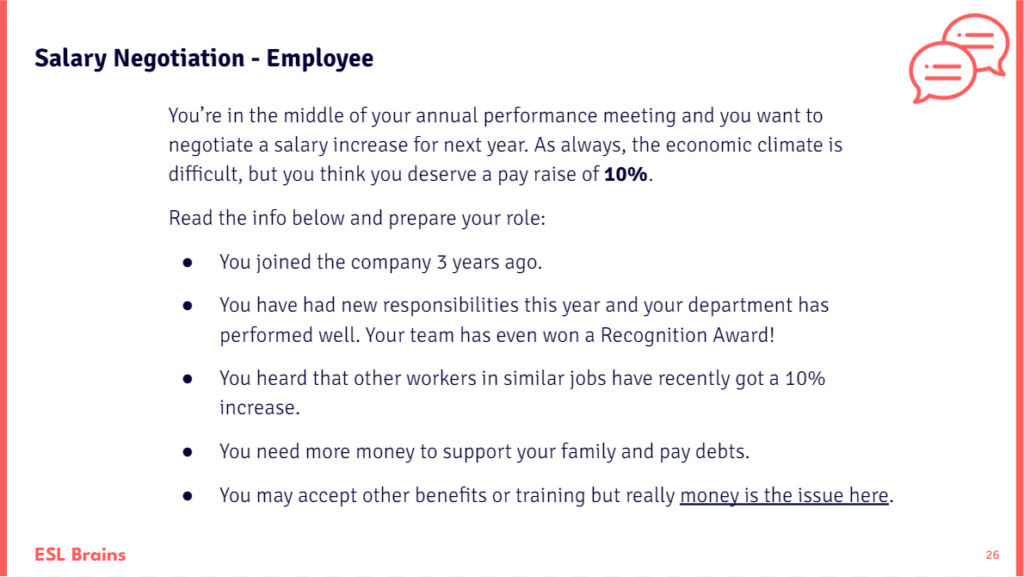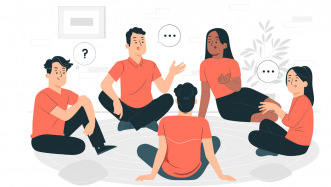Every teacher knows the advantages of incorporating group tasks into ESL lessons. Discussions, debates, controlled conversations, games, role play and project work considerably increase the amount of practice for students. They get an opportunity to work independently, which enhances their motivation and makes them concentrate on the task. Groupwork provides more of a natural linguistic environment, reducing stress due to more intimate group dynamics. By helping one another, students discover things together and are likely to complete their tasks more successfully, which in turn boosts their confidence.
Using group activities with one-to-one classes may not seem particularly exciting or even doable for some teachers. Have you ever wondered how to adapt group activities to provide variety, as well as ensuring your one-to-one students enjoy and benefit from them? Below are a few tips to consider.
BE A CREATIVE PARTNER
One of the most common activities combining elements of pair and groupwork is debates. Students and teachers love them as they give an opportunity to practise important skills, such as turn-taking or presenting. They can be used not only as speaking tasks, but also as preparation for written assignments. The easiest way to perform this activity in a one-to-one class is by becoming your student’s partner. You may want to try several ideas to add variety to this activity.

Of course, you can just let your student choose to argue a particular side in the debate, but you can also assign them one. It may present an extra challenge, but it can also be a positive learning experience for them to argue on the side of the debate they don’t actually believe in.
On a different occasion, and with a stronger and more confident student, you can prepare five arguments in favour before the class and ask them to come up with counter arguments, setting a time limit. While they are working on their arguments, take the role of a facilitator and guide your student when they need assistance, providing vocabulary, or clarification of the task.
With a weaker student, you can set the topic of the debate as homework and ask them to do research and prepare a few arguments in favour and a few against. Once in class, flip a coin to decide who will be arguing in favour of and against the proposition. That will bring an element of surprise but also boost your student’s confidence (as they’re already prepared!) and increase your chances of sparking an interesting discussion.
FIND WAYS TO MONITOR AND GIVE FEEDBACK
The role of a teacher during group activities shifts from resource to monitor or consultant in one-to-one lessons. Becoming your student’s partner in group activities, although the easiest solution, makes it complicated to focus on their mistakes and provide them with immediate feedback. One possible way to overcome this problem is by turning a debate into a short speech (one or two minutes, depending on level) on a topic discussed in the lesson, and therefore delaying your feedback. You can either give your student some time to prepare, ask them to improvise or even set a persuasive speech for homework and use it at the start of your next class. Once the speech is finished, your student receives feedback on different aspects of their performance, such as grammar or pronunciation.

But what about activities such as role play, which require interaction? Giving up on doing them would be a shame as they’re a perfect way for ESL teachers to ease students’ transition into using English in real-world situations.
One possible way of including them in a one-to-one class would be by dividing the roles (teacher: employer, student: employee) and recording the role play using a mobile phone. Once it’s finished, you can listen to the recording together and analyse the mistakes (one time you may want to focus on pronunciation, another time on grammar). Make it more memorable by letting your student try and identify their own mistakes first.

MAXIMISE REAL-LIFE CONTEXT
Apart from being fun and motivating, group activities appeal to many ESL instructors because they broaden the world of the classroom and allow students to rehearse situations they’re likely to experience in the outside world. Implementing this ‘real-life’ context in our one-to-one classes is also possible (and extremely important!). Here is how to do it:
- If your student is quite confident, you could ask them to make phone calls to real places and put into practice what they’ve learnt (this could include making an enquiry about a hotel room, feeding times at the zoo, or even asking a restaurant about their menu). Do it during your class and note down their mistakes while they speak.
- If they don’t feel ready to talk to strangers yet, switch off your Zoom video and simulate a phone call. It’ll be less stressful, but at the same time, more challenging than what they’re used to.
- If your student has friends or relatives who speak English, you could ask them to record an interview/conversation with them as homework (putting into practice the language you worked on in class), then listen to the recording together and comment on strengths and weaknesses.
- Occasionally, you may want to arrange a ‘surprise call’ and ask a fellow teacher to join your Zoom meeting and talk to your student for a few minutes. Choose a topic beforehand (e.g. ask your student to prepare a few questions about the guest’s job, or make it a debate) and then take a back seat in the conversation and take notes. Afterwards, let your student reflect on the task, ask them how they felt, what caused problems and give them advice. This could be a great activity to help your student understand different accents, parts of speech (ums, ahhs and other fillers), and just hear English being used naturally.
PUT YOUR STUDENT FIRST
Experimenting with new ideas and adding variety to your one-to-one classes is always worth it, but don’t forget that being sensitive to your student’s needs and their personal preferences is far more important. Reduce your teacher talk and create opportunities for them to speak English as much as possible. At the same time, choose your activities carefully, prioritising a relaxed environment in which your student feels comfortable and confident enough to produce the language.
We’d love to hear how you make the most of group activities in your one-to-one classes. Please share your ideas below!















Timely reminders Stan, thank you!.
Thank you so much. This is so useful. I will put it into practice real soon, thanks again!
Supper
Great article! Thanks!
I really appreciate it, thanks!
Thanks! It’s amazing to hear that so many people find this article useful 🙂
This is such good advice and yes, we all need a reminder now and then. I will definitely be trying these out. Thank you for all the support you give your teacher subscribers,
Lovely to hear that you like our ideas! Good luck with your classes 🙂